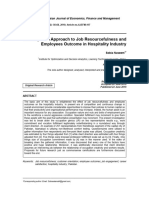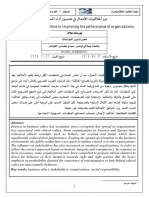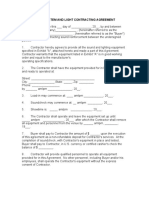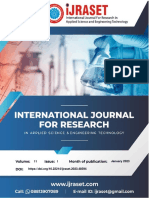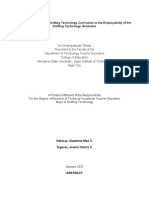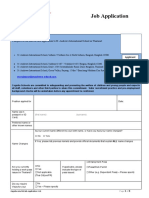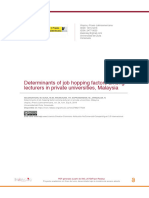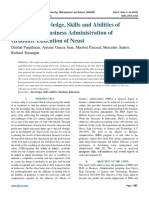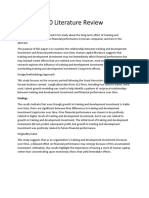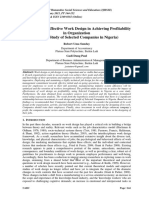Effect of Occupational Transfers On Employee Engagement in Private Universities in Western Kenya
Effect of Occupational Transfers On Employee Engagement in Private Universities in Western Kenya
Volume 9, Issue 3, March – 2024 International Journal of Innovative Science and Research Technology
ISSN No:-2456-2165 https://doi.org/10.38124/ijisrt/IJISRT24MAR825
Effect of Occupational Transfers on Employee
Engagement in Private Universities in Western Kenya
Author: Kerangani James Mariba
Department of Business Administration
School of Business and Economics, Maseno University
Co-Author: Joy Akoth Akinyi Co-Author: Dr. Donald Indiya Gulali
Department of Business Administration Department of Business Administration
School of Business and Economics Maseno University School of Business and Economics Maseno University
Abstract:- According to Makori, M. & Kariuki, N., (2015), effect on employee engagement. The study suggested that
a study was conducted in Presbyterian University of East private universities in western Kenya should communicate
Africa (PUEA) by the HR Office in 2014 and disclosed that to their employees before they are transferred.
about 50% of employees in Kenyan institutions of Higher
Learning merely come to work to do what is needed of Keywords:- Occupational Transfers, Employee Engagement.
them. The study showed that 47% of workers came to
work and ended up using most of their time on social I. INTRODUCTION
websites during work hours. Hence workforce turnover
was registered at 43%. The major cause of these situations Occupational Transfers
is not known. Scholars have given many suggestions that In many businesses, occupational transfers do happen.
some Occupational changes in private universities are Suzuki, a Kobe University organizational behavioral specialist
linked with digitalization, how information is shared, provided evidence for this, he tracked the differences in the
relocation of workers, change in task objectives and dynamics between the ancient and modern Occupations for 20
production costs. Nevertheless, it is not known whether years. He also looked at how the relationships between
these changes have any significant effect on employee Japanese corporations and labor have changed. He concluded
engagement in Kenyan private universities. This study that since the end of World War II, firms in Japan have shifted
therefore was particularly concerned with the Effect of from the concept of lifetime employment, which became
Occupational Transfers on Employee Engagement in deeply ingrained during the postwar economic boom. This has
Private Universities in Western Kenya. The conclusions of resulted in a significant cultural shift in the country's
this study might be very useful to many stakeholders occupational landscape (Katol & Suzuki, 2006).
involved in the management of Private universities in
Kenya. The study was based on the Job Characteristics Workers worry that they may lose their employment or
theory. Correlational research design was used. Target be moved to other positions which might lead to stress at
population was 1440 workers of four selected Private work, including anxiety, tension, and wrath. On the other
Universities. Stratified random sampling techniques were hand, Changing careers can force workers to think in fresh and
employed. The sample of 313 workers from different interesting ways. One advantage of creative thinking within
sections was used. Questionnaires were given to the corporation is the generation of several inventions and
Respondents to complete for the purpose of data collection. concepts that can be utilized to maintain the business dynamic,
Questionnaire were developed using items from literature fascinating, and profitability. (Kotler, 1999). A 2014 Oxford
reviews. SPSS and Excel tools were used during the data Economics Workforce 2020 study found that during periods of
analysis process. Data was presented using charts and significant occupational shifts, business organizations in South
Frequency tables. From the results, conclusions and Africa face challenges in managing talent, developing
recommendations were made. A pilot study was carried leadership, comprehending people, and promoting learning.
out with 10 respondents from Uzima University to assess The Systems Applications and Products (SAP) group
the validity of the research instruments. The 10 commissioned the study, which found that occupational
respondents were not involved in the main study. The transfers were the most popular occupational trend in South
results revealed that occupational transfers had a negative Africa (59%), which was followed by the entry of so-called
effect (β=-.541, p<.05) and accounted for 29.3% variance millennial into the workforce (54%), and the
in employee engagement (R2=.293, p<.05). It was internationalization of the workforce (43%) (Brynjolfsson &
concluded that Occupational Transfers have a significant McAfee, 2014).
IJISRT24MAR825 www.ijisrt.com 887
Volume 9, Issue 3, March – 2024 International Journal of Innovative Science and Research Technology
ISSN No:-2456-2165 https://doi.org/10.38124/ijisrt/IJISRT24MAR825
Karanja (2015) argue that the digital age has brought workplace, such as workforce reorganization, and employee
both great possibilities and difficulties to a number of Kenyan engagement in higher education. Additionally, the authors
enterprises. Businesses perceive that monitoring operations have not indicated what field of study or applicability of their
has become a challenge because of the swift change in recommendations, nor have they demonstrated how these
occupational fields. She also noted that, at 61%, occupational similar obstacles and intervening strategies may be recognized
transfers have been the most common type of occupational and established independently at either public or private
shift, forcing firms to implement late tactics in order to avoid higher education institutions. Therefore, the goal of the
fierce competition. Karanja came to the conclusion that research was to determine whether occupational transfers have
changes in a worker's occupation might affect every facet of any apparent effect on employee engagement in Kenya's
the business's operations. Most of these adjustments are driven private universities.
by the need to adapt to new possibilities or problems brought
about by the atmosphere of the organization. However, In their study "Effect of Occupational Changes on
Karanja's research on the impact of occupational shifts on Performance in Kenyan Private Universities," Rael, Dinah,
performance was too wide to establish a connection between and Kipkebut (2019) found that universities have implemented
similar changes—for example, occupational transfers and a number of novel tactics to counteract occupational changes,
employee engagement—and other factors. such as occupational transfers, that affect their real efficiency.
The authors, nevertheless, could not understand as to why
Higher Education in Kenya Kenyan colleges have differing ratings, with some being
In Kenya, there are essentially two categories of ranked well and others poorly. Therefore, the main objective
universities: private and public. Public universities are owned of this study was to ascertain if occupational transfers affect
and supported by the state. Private persons or organizations, employee engagement at Kenyan private institutions.
some of which are religious, are in charge of private
universities. Tuition fees and sponsorship provide the lion's Employee Engagement
share of the organization's revenue. Like all other universities, Employee views, optimistic outlook, self-perception, and
private universities in Kenya function in an environment that self-assurance in the company are just a few of the elements
is dynamic and competitive. To sustain efficiency, they have that make up employee engagement. It is also affected by the
to give up a lot of their long-standing customs in favor of company's mission goals, predetermined course, daily
unproven future routes (Okenda, Thuo, & Kithinji, 2017). decisions, and staff appreciation (Saxena, 2012). Employee
Adjustments in private universities are mostly focused on job satisfaction, pride in one's work, attitude toward one's
organizational communication, technological advances, work, and occupational impacts are all components of an
behavioral changes, and strategic planning. The engaged workforce. Workers take joy in their work when they
implementation of novel approaches differs throughout approach it with enthusiasm and accountability. An
universities and could impact real output. The real cause for employee's response to a manager who stands by them and
the disparity in university rankings, where some continue to be defends their actions or productivity is increased satisfaction,
ranked poorly while others are ranked highly, is still a mystery which has a direct and beneficial impact on employee
(Okenda, Thuo, & Kithinji, 2017) engagement (Linz & Huddleston, 2006). Adding to this, Shuck
et al. (2010) contend that employee engagement literature
The employment of new technologies, a change in needs to start paying much more attention to the occupational
advertising approaches, and the hiring of exceptionally context in order to properly comprehend how and why
qualified individuals are the outcomes of Kenya's higher employee engagement is not fulfilled in private colleges.
education transition (Mathooko, 2013). Higher education (HE)
is evolving due to several main issues, according to Boston These writers have attempted to provide evidence to
(2000): rising expenses, a growing focus on college ratings, support their explanation of the poor employee engagement
changing student demographics, and increased parental observed in Kenyan private universities, but they have not
concern about educational quality. To remain competitive in a addressed the root causes of these issues or whether
global marketplace, universities have tried to adopt the occupational transfers in the workplace could be a factor in the
following strategies: superior quality compared to rival low engagement of the workforce. However, the HRO report
institutions, cutting-edge technology, effective communication in the PUEA does not identify or even mention the causative
techniques, and reorganizing their staff in terms of abilities, factors that result in these manifestations of low employee
knowledge, and talent management (Watson, 1996). engagement in higher learning institutions. Instead, it
speculates extensively about the implications of low employee
While Mathooko (2013), Boston (2000), and Watson engagement for organizations and individual workers. This
(1996) made an effort to clarify some of the developments in study aimed to assess the effect of Occupational transfers on
higher education, as well as the variables that led to these employee engagement in Kenya's private universities, in light
changes and subsequent modalities, they were unable to of these observations and gaps.
explain the connections between these changes in the
IJISRT24MAR825 www.ijisrt.com 888
Volume 9, Issue 3, March – 2024 International Journal of Innovative Science and Research Technology
ISSN No:-2456-2165 https://doi.org/10.38124/ijisrt/IJISRT24MAR825
Statement of the Problem diversity of skills all impact three psychological states.
Private universities in Kenya are currently experiencing Because of this, a range of possible outcomes, including job
substantial employee turnover, subpar work performance, satisfaction, absenteeism, and occupational engagement, is
inadequate service standards, and a dynamic workplace influenced by the three psychological states. (Hackman,
marked by frequent occupational changes. The main obstacles 1975). Three psychological states—meaningfulness of work,
are figuring out what creates these situations and how to draw responsibility, and awareness of outcomes—are linked to high
in and keep talented, committed employees. Several studies occupational motivation according to Hackman and Oldham's
have been conducted to assess the level of staff engagement in job characteristics motivation theory. From an organizational
Kenya's private universities. Most of the researches have perspective, it is anticipated that enhancing the specifics of
repeatedly shown that despite the high standards that different essential job responsibilities will lead to increased
stakeholders have put in place, a common problem is low staff occupational satisfaction and employee engagement
satisfaction. Moreover, there is a lack of proficiency in the (Hackman, 1975).
administration of student relations, public involvement, and
consumer relations within Kenyan private Universities. Three crucial psychological states, according to
However, the causes of these occurrences are unknown, which Hackman (1975), are in charge of many fruitful personal and
is why this study was conducted. On the other hand, studies professional outcomes. They are listed in the following order:
have indicated that transfer activities may be one of the
occupational changes in private higher education institutions; The Subsequent are Crucial Attributes of the Job:
nevertheless, it is unknown if these changes have any effect on The degree to which a job demands an employee to
employee engagement, which is why this study was execute a range of tasks and develop a range of competencies
conducted. is referred to as skill variety. Employees may find greater
purpose in work demanding a broad range of skills and
Objective of the Study abilities than in tasks that are straightforward and routine.
The purpose of this study was to ascertain the effect of
occupational transfers on employee engagement in private Task Identity:
universities in western Kenyan. The degree to which job holders must locate and finish a
task with a defined outcome; when workers are accountable
The study was guided by this hypothesis: for all stages of the process instead of just a few, their work
takes on greater significance for them
H01: There is no significant Effect of Occupational Transfers
on Employee Engagement in private universities in western Task Importance:
Kenya. How much a task impacts other people's lives. There may
be an impact on the immediate organization or the
surroundings. When their profession considerably improves
people's physical or mental health, employees feel that their
work is more meaningful than if it has minimal effect to
anyone else.
Autonomy:
The degree to which an employee has a great deal of
latitude, self-governance, and discretion in choosing how to
set up their work and fulfill their duties. In professions where
employees have a high degree of autonomy, their work
outcomes are decided by their own initiative, efforts, and
decisions rather than by directives from management or a task
Fig 1 Conceptual Framework process manual. Employees feel more responsible for both
professional success and failure when this occurs.
II. THEORITICAL REVIEW
Feedback:
Job Characteristics Theory The degree of comprehension of the result by the staff
Under the work characteristics theory that was created by member. This data regarding how well he or she performs
Hackman and Oldham in 1975, the task itself is considered to their work is precise, comprehensive, and useful. When
be crucial to employee engagement. The job characteristic employees obtain clear, actionable information on their work
model states that intrinsically motivated features are fostered performance, they are better able to comprehend the overall
by the occupational setting, which leads to job satisfaction. effects of their work activities and what precise measures (if
The factors of task identification, autonomy, feedback, and any) they need to take to increase their productivity.
IJISRT24MAR825 www.ijisrt.com 889
Volume 9, Issue 3, March – 2024 International Journal of Innovative Science and Research Technology
ISSN No:-2456-2165 https://doi.org/10.38124/ijisrt/IJISRT24MAR825
Experienced Meaningfulness of Work: Schalts (2010) claims that an employee's productivity
This is the degree to which an employee believes their may drop when transferred to a new work environment until
work has intrinsic value and can articulate that value to others he has adjusted to the new location. Moving an employee to a
and/or the outside world. Experienced Responsibility for new office building, changing offices, or simply renovating an
Exercise Outcomes: The extent to which a worker feels office space can have the same effect on employees as moving
responsible and in charge of their exercise outcomes; the to a new residence does on a family. The study's findings also
extent to which a worker is conscious of their performance in indicate that employees may experience stress and anxiety
connection to the results of their work activities. The original when taking on new positions. Workers could also be hesitant
theory's personal and professional outcomes, which were to move from their previous job and make minimal
predicated on earlier research, included performance quality, contributions to their new section. Additionally, the survey
absenteeism and turnover, internal work motivation, and job found that employees view new jobs as formalities and
satisfaction—all of which are important elements of employee procedures, which makes them reticent to share their thoughts
engagement. Thus, this theory will aid in our comprehension in a new team or open up to new colleagues. The survey also
of the relationship between the two variables as well as found that although most workers feel highly at ease working
whether or not changes at the occupational level have an with people they have known for a long time, they find it very
impact on the inherent characteristics of employee difficult to get used to new coworkers, which lowers their
engagement. engagement.
Compared to Herzberg's theory, the job characteristic Harrison (2000) however, found that some firms see
model is backed by more empirical data. Critics point out that transfers as a great way to boost morale and encourage
many studies that employ this model ignore important employee engagement in his paper on the Effect of Transfer
psychological states entirely, focusing only on the direct and Incentive on Employee Performance. The study found that
effects of fundamental job aspects on personal and while moving can occasionally be difficult, it doesn't have to
professional outcomes (Behnson, 2010). This has led to be chaotic; instead, it can result in a motivated, invigorated,
criticism of the approach. This hypothesis will therefore be and reenergized workforce that is ready to contribute to the
relevant to the current study. company's success. According to the report, managers should
consult with staff members ahead of time to find out their
III. EMPIRICAL REVIEW opinions before relocating an office. Their engagement will
rise as a result of this, helping them get ready for a change.
In the contemporary world, the quality of occupational According to the study's findings, employee engagement and
transfers is a constant source of concern for any institution or productivity both decline when transfers are made
organization, especially when it comes to putting transfer rules insufficiently or incorrectly, but the contrary is also right.
into place that guarantee staff members' continued engagement
to meet the objectives. Lee (2011) defines a transfer as a Behnson (2010) divides occupational transfer issues into
lateral shift as the moving of people from one position to two categories: issues that are connected to the workplace and
another without a major alteration in the responsibilities, issues that are not. Transitioning to a new workplace and
duties, skills needed, or pay. accepting additional responsibilities are examples of work-
related concerns; decisions on relocation, social and emotional
According to Black's (2004) study, which examined the strain, and other matters fall under the category of non-work-
relationship between occupational transfers, work motivation, related concerns. The study also notes that poor performance,
and employee performance, an employee may find it resistance, and poor quality of work can arise from
challenging to adjust to a new workplace, role, and supervisor unintentional occupational transfers. The study did not
when they are transferred to a new work office. The study also however demonstrate a relationship between occupational
showed that, even in cases where a transfer is beneficial, an transfers and low employee engagement, hence leading to this
employee may find it challenging to get to know a new study.
supervisor when they are assigned to a different department or
location. The study finds that while some workers find the IV. RESEARCH METHODOLOGY
unknown unsettling, others find it thrilling. It may be difficult
for them to adjust and function in the new setting, which The use of questionnaires intended to elicit respondents'
lowers satisfaction. Since it sought to explain the relationship opinions and views on the issues affecting the study helped to
between occupational transfers, work motivation, and ensure that accurate data was collected. (Orwaru, 2014). The
employee performance even in cases where the transfers are study's target population was the staff members of four private
good, this study was necessary. universities in the Western Kenya region. The universities
included: University of Eastern Africa, Baraton in Nandi
County, Kenya Highlands University in Kericho County,
Great Lakes university of Kisumu in Kisumu County and
IJISRT24MAR825 www.ijisrt.com 890
Volume 9, Issue 3, March – 2024 International Journal of Innovative Science and Research Technology
ISSN No:-2456-2165 https://doi.org/10.38124/ijisrt/IJISRT24MAR825
Uzima University in Kisumu County. It comprised 140 heads Y =β0 +β1X1+ ɛ
of departments, 230 supervisors and 1070 operational
workers; both teaching and non-teaching staff (see table 3.1). Where; Y = Employee engagement in private
In terms of gender, age, ethnicity, work experience, and universities
educational backgrounds, the target audience was diverse.
β0 = The constant or coefficient of intercept.
Because respondents in this study came from different X1 = Occupational Transfers.
employment cadres, a stratified sampling technique was used ɛ = Error term
to ensure that the samples drawn from every stratum were
fairly represented in the overall sample and that their numbers β1 = Corresponding coefficients for the
in the targeted population as a whole remained proportionate respective in dependent variables.
was crucial. By applying the stratified sampling technique, the
researcher was able to reduce the possibility of biases during
V. FINDINGS OF THE STUDY
the sample selection process from the target population
(Kothari, 2009). The researcher used Yamane’s formula (cited Demographic Characteristics of the Respondents
in Njugi & Muna 2021) as follow: The demographic features of the respondents were
investigated before the actual process. These included the
n= N /1+N (e) 2 gender, educational attainments, and employment experience
of the respondents. The results are displayed as Table 1
Where N is the size of the population, e is the margin of error, illustrates
and n is the sample size (0.05)
Table 1: Demographic Characteristics of the Respondents
n= 1440 / 1+1440(0.05)2 Gender Frequency Percent
Female 128 42.8
n = 313
Male 171 57.2
Thus, a sample of 313 was picked from a population of Total 299 100.0
1440workers (See Table 2) Level of Education Frequency Percent
Diploma 34 11.4
The study employed a questionnaire on a Likert scale as
the tool for primary data collection. This was directed by the Degrees 62 20.7
goals of the research. Because the respondents were already PHDs 124 41.5
aware with the parameters being studied, it was thought Masters 79 26.4
suitable to use a self-administered questionnaire to collect data Total 299 100.0
for this study (Mugenda & Mugenda, 2003). Respondents
from a range of departments were given questionnaires to Occupation Frequency Percent
complete in order to gather their opinions on the impact of HODs 30 10
occupational transfers on employee engagement in private Supervisors 48 16.1
universities in Western Kenya. The researcher gave them time Operational Workers 221 73.9
to finish filling the questionnaires before gathering them. The
Total 299 100.0
instruments were assessed for validity by experts with
backgrounds in higher education and HR management. To Work experience in Frequency Percent
calculate the surveys' coefficient of internal consistency, the years
researchers used the split-half method. As a result, the 1-5 years 71 23.7
dependability was determined to be 0.78 which was suitable 6-10 years 51 17.1
for data collecting. 11-15 years 123 41.1
Data analysis w a s d o n e through regression model over 15 years 54 18.1
Adopted from Fairchild & Mackinon (2009) & Whisman Total 299 100.0
and McClelland (2005)
The results indicates that a big percentage of the
respondents were male, 171(57.2%) while the smaller
percentage were female respondents 128(42.8%). The findings
also indicates that most of the respondents, 124(41.5%) had
PhDs followed by 79(26.4%) who had Master’s Degrees,
62(20.7%) with bachelor’s degrees and lastly 34(11.4%) who
IJISRT24MAR825 www.ijisrt.com 891
Volume 9, Issue 3, March – 2024 International Journal of Innovative Science and Research Technology
ISSN No:-2456-2165 https://doi.org/10.38124/ijisrt/IJISRT24MAR825
are diploma holders. Moreover, the findings also indicates Findings on the Effect of Occupational Transfers on
that many of the respondents, 221(73.1%) belong to Employee Engagement
operational level work followed by 48(16.1%) who are The study sought to establish the effect of occupational
supervisors then 30(10%) were HODs. These results showed a transfers on employee engagement in private Universities in
true representation of higher Education workforce where the western Kenya region. Hence, respondents on both variables
majority have PHDs. The study's demographic features were gave data which was collected and later correlated.
crucial because they gave insight into the types of respondents
who took part. For example, the presence of respondents with The study sought views from the respondents
advanced degrees, such a PHD, suggests that the opinions considering different factors related to occupational transfers.
expressed came from people who knew more about The statements were generated on a scale of 1-4, showing the
universities. Experience also demonstrates that the extent to which they agreed with each statement: where: 1=
respondents have knowledge of university affairs, making strongly disagree, 2= disagree, 3= agree and 4= strongly
them qualified to offer trustworthy information. agree. The findings are presented as shown in Table 4.7 that
follows.
Table 2 Occupational Transfers Practices
Statement 1 2 3 4 M STD
14(4.7) 63(21.1) 157(52.5) 65(21.7) 2.9 .78
Do you agree or disagree that new supervision leads to low employee
engagement in privateuniversities in western Kenya?
Do you agree or disagree that moving employees to new work offices 6(2) 93(31.1) 168(56.2) 32(10.7) 2.8 .66
reduces their engagement in private universities in western Kenya?
5(1.7) 109(36.5) 137(45.8) 48(16.1) 2.8 .73
Do you agree or disagree that shifting employees to new roles decreases
their engagement inprivate universities in western Kenya?
26(8.7) 72(24.1) 147(49.2) 54(18.1) 2.8 .85
Do you agree or disagree that working with new and unfamiliar
workmates reduces employee engagement in private universities in
western Kenya?
Source, (Field Survey, 2022)
Key-1= strongly disagree (SD), 2= disagree (D), 3= agree (A) and 4= strongly agree (SA), M-Mean, STD-Standard deviation
The findings showed that 157(52.5%) of the respondents (M=2.8, SD=.85). Most of workers who participated in the
agree that new work supervision can leads to low employee study showed that new work supervision led to low employee
engagement in private universities in western Kenya, engagement. They also indicated that transferring employees
which also had a highrating (M=2.9, SD=.78). Additionally, to new tasks and working with unfamiliar workmates lowered
relocating employees to new work offices lowers their their engagements.
engagement in private universities in western Kenya as
indicated by majority of the respondents, 168(56.2%) of the Hypothesis Testing for Objective 2: Effect between
respondents who were in agreement, also with a high rating Transfers of Employees and their Morale
(M=2.8, SD=.66). Further analysis showed that shifting Determining the effect of occupational transfers on
employees to new tasks decreases their engagement in private employee engagement was the objective of this study. "There
universities in western Kenya as showed by 137(45.8%) of the is no significant effect between occupational transfers and
respondents and a high mean and low standard deviation employee engagement in private universities in western
(M=2.8, SD=.73). The low means indicate that occupational Kenya," was the null hypothesis of this study. Both basic
transfer practices are exercised to a small magnitude while the linear regression models and Pearson product moment
small standard deviations shows that the respondents’ views correlation were used to test this.
had small variations thus highly agreed. Lastly, the findings as
showed by many of the respondents, 147(49.2%) indicate that Table 3 presents additional data using a simple linear
working with unfamiliar workmates lowers employee regression model to determine whether occupational transfers
engagement in private universities in western Kenya region have an effect on employees' engagement.
IJISRT24MAR825 www.ijisrt.com 892
Volume 9, Issue 3, March – 2024 International Journal of Innovative Science and Research Technology
ISSN No:-2456-2165 https://doi.org/10.38124/ijisrt/IJISRT24MAR825
Table 3 Effect between Occupational Transfers and their Morale
Model Summary
Model R R AdjustedR Std. Errorof the Change Statistics
Square Square Estimate R Square F df1 df2 Sig. F Change
Change Change
1 .541a .293 .291 .42651 .293 123.126 1 297 .000
a. Predictors: (Constant), transfer
Coefficientsa
Model UnstandardizedCoefficients StandardizedCoefficients T Sig.
B Std. Error Beta
1 (Constant) 1.339 .137 9.810 .000
transfer .528 .048 -.541 11.096 .000
a. Dependent Variable: employee engagement
Table 3 presents evidence indicating that occupational VII. CONCLUSIONS
transfers have a significant and negative effect on employees'
engagement, in accordance with the correlation coefficient The study's goal was to determine the relationship
(β=-.541, p<.05). Furthermore, the coefficient of between occupational transfers and employee engagement in
determination (R2=.291, P<.05) shows that occupational private universities. Occupational transfers may be significant
transfers explain for 29.1% variance in their engagement. It is for a variety of reasons, and it would be advantageous if they
implied by this that moving personnel around affects their were done voluntarily or at their leisure. On the other hand, if
engagement. In light of these results, the alternative a transfer is made with force, the impacted workers eventually
hypothesis—which holds that occupational transfers lose motivation to work. Generally, if an occupational transfer
significantly affect employees' engagement and cause it to is voluntary, employees' engagement will rise; if it is forced,
decline—was accepted in place of the null hypothesis. These however, engagement may fall. Therefore, it can be said that
results agree with the findings of a study conducted by Black changes in their line of work have a big impact on their
(2004) on the relationship between occupational transfers and engagement.
employee performance, which revealed that an employee may
experience adjustment issues upon moving to a new RECOMMENDATIONS
occupational setting due to the presence of a new supervisor,
office, roles, and coworkers. The results also support those of While occupational transfers are crucial for the
Schalts (2010), who found that relocating an employee to a performance of western Kenyan private colleges, the current
new office building, switching offices, or even just remodeling study suggests that occupational transfers—where they can be
an office space can affect workers in the same way that assigned various jobs to boost morale at work—should receive
relocating a family to a new home does. Until an employee greater attention.
adjusts to his new work environment, his productivity may
decline. Thus, it can be said that occupational transfers REFERENCES
negatively affect employee engagement.
[1]. Boston, C. (2000). The Social Scientific Study of
VI. SUMMARY OF FINDINGS Leadership: Quo vadis. Journal of Management,23, 409-
473. In Yang, K. S., Hwang, K. K., & Kim, U. (Eds.).
The study's goal was to determine the relationship [2]. Cummings, S., Bridgman, T. & Brown K. (2006).
between occupational transfers and employee engagement in Unfreezing change. Paris: SAGEPublishers.
western Kenya's private universities. The results showed a [3]. Karanja, A. (2015). Organizational Change and
substantial negative association between occupational Employee Performance. European Journal ofBusiness
transfers and employee engagement. The results showed that and management, vol.7 issue no.11, 2015.
occupational transfers had a negative and significant effect on [4]. Longo, R. (2011). Validity of Lewins Change Model.
employee engagement using a simple linear regression model. Journal of HRprofessionals,vol.2(5).
It appears from this that moving staff around affects their [5]. Mathooko, S. R. (2013). Performance Measurement and
engagement. Control Systems for Implementing Strategy. Upper
Saddle River, NJ: Prentice Hall.
[6]. Orwaru, S., Apollo, L. & Belinda K. (2014). Factors
Affecting Utilization of ICT in public organizations. The
international Journal of business management,
vol.23(1).
IJISRT24MAR825 www.ijisrt.com 893
Volume 9, Issue 3, March – 2024 International Journal of Innovative Science and Research Technology
ISSN No:-2456-2165 https://doi.org/10.38124/ijisrt/IJISRT24MAR825
[7]. Rael S., Dinah J., and Kipkebut (2019). Effect of [23]. Industrial Relations. The journal of Economy & Society,
Organisational Change on Performance in Kenyan vol.43(1).
Chartered Universities: A Sector Comparison. European [24]. Schalts, P. & Sydney, E. (2010). Psychology and work
Journal of Business and Management www.iiste.org today. Upper Saddle River, Prentice Hall.
ISSN 2222-1905 (Paper) ISSN 2222- 2839 (Online) [25]. Harrizon, J. (2000). HRManagement for Small Business
DOI:10.7176/EJBM Vol.11, No.18, 2019 in New Zealand. Asia pacific journal of human resource,
[8]. Saxena, C. (2012). Employee engagement Indicator Vol.38(2).
of Success or Failure of an Organization. Journal of [26]. Njagi, C. N., & Muna, W. (2021). Performance
Baudhik, vol. 3(2). Management Startegies and Employee Productivity in
[9]. Shuck, B., & Wollard, K. (2010). Employee Engagement the Ministry of Water and Irrigation in Nairobi City
and HRD: A Seminal Review of The Foundations. County, Kenya. European Journal of Human Resources,
HRDevelopment Review,9(1), 89-110. 5(2),1-18.
[10]. Spector, P. (1997). Job satisfaction and consequences. [27]. Mugenda, M. & Mugenda, O. (2003). Research methods-
London: Sage publishers. qualitative and quantitativeapproaches. Nairobi Kenya:
[11]. Taber, T. & Alliger, G. (1995). A Task Level Acts publishers.
Assessment of Job Satisfaction. Journal of organizational
behavior, vol. 53(2).
[12]. Watson, D. (1996), ―Quality Assessment and Self-
Regulation; The English Experience, 1992-94‖, Higher
Education quarterly, volume 49 number 4, pp 326-40
[13]. Kariuki, N. & Makori, M. (2015) Role of Job Design on
Employee Engagement in Private Universities in Kenya:
A Case of Presbyterian University Of East Africa.
Strategic Journal of Business & Change Management.
ISSN:2312-9492
[14]. Kato, L. & Suzuki, M. (2006). Understanding career
development in Japan. Kobe university press.
[15]. Kothari, M. (2009). Research techniques. (2nd edition),
new Denhill India: Person’s publishers. Kotler, C.
(1999). Organizational change. London: Pitman
Publishers.
[16]. Brynjolfsson, S. & McAfee, N. (2014). The second
machine age: Work, progress and prosperity in time of
brilliant technology. New York: Association for
computing publishers.
[17]. Okenda, R., Thuo, A. & Kithinji, M. (2017). Effects of
change on organizational performance: A case of the
Ministry of Environment, Water and Natural Resources.
International Academic Journal of HRand Business
Administration, 2(3), 501-520.
[18]. Linz, S., Good, K. & Hddleston, P. (2006). Employee
engagement and Organizational Trust. Shdhh
international referred research Journal, vol. III 36.
[19]. Hackman, J. & Oldham, G. (1975). The Development of
the Job Diagnostic Survey. Journal of applied psycology,
vol.5(3).
[20]. Behnson, S. (2010). Using Relative Weights to
Reanalyze Settled Area of Organizational Behavior.
International journal of management and information
systems, vol. 5(6).
[21]. Lee, C. (2011). Low staff morale and burnout:
Prevention and possible solution. University of Illions,
Urbana- Champaign.
[22]. Black, S., Lynch, M. & Krivelyova, A. (2004). How
Workers Fare when Employers Innovate.
IJISRT24MAR825 www.ijisrt.com 894
You might also like
- Effect of Career Advancement Opportunity and Work-Life Balance On Employee Retention in NigeriaNo ratings yetEffect of Career Advancement Opportunity and Work-Life Balance On Employee Retention in Nigeria9 pages
- Strategic Management Accounting - A Practical Guidebook With Case Studies-Springer Singapore (2018) - Pakai - Ch.4No ratings yetStrategic Management Accounting - A Practical Guidebook With Case Studies-Springer Singapore (2018) - Pakai - Ch.418 pages
- Key Determinants Influencing Workforce Mobility among Educators in Private Secondary Schools in Amuwo-OdofinNo ratings yetKey Determinants Influencing Workforce Mobility among Educators in Private Secondary Schools in Amuwo-Odofin9 pages
- Retention and Turnover of Staff Undertaking Degree Studies LlmbfwreNo ratings yetRetention and Turnover of Staff Undertaking Degree Studies Llmbfwre21 pages
- An Empirical Approach To Job ResourcefulNo ratings yetAn Empirical Approach To Job Resourceful13 pages
- Job Shift From Industry To Academe: The Plight of Education Unit Earners Teaching TLE SubjectsNo ratings yetJob Shift From Industry To Academe: The Plight of Education Unit Earners Teaching TLE Subjects17 pages
- International Journal of Social Science and Human ResearchNo ratings yetInternational Journal of Social Science and Human Research13 pages
- دور أخلاقيات الأعمال في تحسين أداء المنظماتNo ratings yetدور أخلاقيات الأعمال في تحسين أداء المنظمات14 pages
- The Impact of Reward Management Systems on Employee Retention will be Examined through a Case Study of the Anti-Corruption Commission in Freetown, Sierra LeoneNo ratings yetThe Impact of Reward Management Systems on Employee Retention will be Examined through a Case Study of the Anti-Corruption Commission in Freetown, Sierra Leone42 pages
- The Changing Nature of Quality of Work The Employee Perspective Report - FSCNo ratings yetThe Changing Nature of Quality of Work The Employee Perspective Report - FSC48 pages
- The Goal by Eliyahu M. Goldratt - SummaryNo ratings yetThe Goal by Eliyahu M. Goldratt - Summary31 pages
- Effects of Strategic Change on EmployeesNo ratings yetEffects of Strategic Change on Employees20 pages
- Job Satisfaction of Non-Teaching Its Relationship To University Policies and Leadership Styles Linked To Their Performance Based For Proposed ProgramNo ratings yetJob Satisfaction of Non-Teaching Its Relationship To University Policies and Leadership Styles Linked To Their Performance Based For Proposed Program10 pages
- Batch 2018 - Impact of Drafting Technology Curriculum To The Employability of The Drafting Technology GraduatesNo ratings yetBatch 2018 - Impact of Drafting Technology Curriculum To The Employability of The Drafting Technology Graduates120 pages
- The Influence of Competency, Compensation and Work Discipline On Performance With Job Satisfaction As An Intervening Variable in Fishery Business Expert Polytechnic Lecturers (Poltek Aup)No ratings yetThe Influence of Competency, Compensation and Work Discipline On Performance With Job Satisfaction As An Intervening Variable in Fishery Business Expert Polytechnic Lecturers (Poltek Aup)9 pages
- Employee Job Satisfaction in Developing Countries: The Case of KenyaNo ratings yetEmployee Job Satisfaction in Developing Countries: The Case of Kenya19 pages
- Relationship Between Workplace Technological Changes and Employee Morale in Private Universities in Western KenyaNo ratings yetRelationship Between Workplace Technological Changes and Employee Morale in Private Universities in Western Kenya8 pages
- Determinants of Job Hopping Factors AmongNo ratings yetDeterminants of Job Hopping Factors Among11 pages
- Book 6: Essentials of Cost and Management AccountingNo ratings yetBook 6: Essentials of Cost and Management Accounting96 pages
- The Impact of Leave Practices On Employees' Well-Being and Organizational Performance: The Case of Morogoro Municipality, TanzaniaNo ratings yetThe Impact of Leave Practices On Employees' Well-Being and Organizational Performance: The Case of Morogoro Municipality, Tanzania7 pages
- Factors Influencing Labour Turnover within Public Institutions in NamibiaNo ratings yetFactors Influencing Labour Turnover within Public Institutions in Namibia8 pages
- Acquired Knowledge, Skills and Abilities of Graduates of Business Administration of Graduate Education of NeustNo ratings yetAcquired Knowledge, Skills and Abilities of Graduates of Business Administration of Graduate Education of Neust4 pages
- Employee Perception of the Organizational Employee Retention Strategies in State Owned Insurance FirmNo ratings yetEmployee Perception of the Organizational Employee Retention Strategies in State Owned Insurance Firm11 pages
- Design and Implementation of A Collaborative Freelancers' Sourcing PlatformNo ratings yetDesign and Implementation of A Collaborative Freelancers' Sourcing Platform20 pages
- Influence of Employee Experience on Organizational Functions: A Conceptual ViewNo ratings yetInfluence of Employee Experience on Organizational Functions: A Conceptual View7 pages
- Group 5: Nutrasty de Verderas Narrative ReportNo ratings yetGroup 5: Nutrasty de Verderas Narrative Report4 pages
- Evaluating the Impact of Shopee Mall on Consumer Purchase: Basis for Developing an Effective Marketing PlanNo ratings yetEvaluating the Impact of Shopee Mall on Consumer Purchase: Basis for Developing an Effective Marketing Plan61 pages
- Forrester Report - Predictions 2021 - Automation0% (1)Forrester Report - Predictions 2021 - Automation3 pages
- Unlocking the Therapeutic Power of Coriander: A Review of Coriandrum Sativum’s Bioactive Compounds and Health BenefitsNo ratings yetUnlocking the Therapeutic Power of Coriander: A Review of Coriandrum Sativum’s Bioactive Compounds and Health Benefits15 pages
- Crude Oil Price Volatility and its Impact on Nigeria’s Balance of Trade: An Empirical Assessment (2000–2023)No ratings yetCrude Oil Price Volatility and its Impact on Nigeria’s Balance of Trade: An Empirical Assessment (2000–2023)13 pages
- Investigating the Interplay between Climate Change and Sustainable Environment Development: Challenges, Strategies and Future DirectionsNo ratings yetInvestigating the Interplay between Climate Change and Sustainable Environment Development: Challenges, Strategies and Future Directions11 pages
- Developing Gamified Educational Technologies to Enhance Learning and Motivate Student Engagement in Education: A Quantitative Study Using Human-Computer Interaction (HCI)No ratings yetDeveloping Gamified Educational Technologies to Enhance Learning and Motivate Student Engagement in Education: A Quantitative Study Using Human-Computer Interaction (HCI)16 pages
- Enhancing the Robustness of Computer Vision Models to Adversarial Perturbations Using Multi-Scale Attention MechanismsNo ratings yetEnhancing the Robustness of Computer Vision Models to Adversarial Perturbations Using Multi-Scale Attention Mechanisms14 pages
- Monte Carlo-Based Modeling of 2-D Ising Systems Using Metropolis Algorithm, Simulation Techniques, Thermodynamic Behavior and Magnetization PatternsNo ratings yetMonte Carlo-Based Modeling of 2-D Ising Systems Using Metropolis Algorithm, Simulation Techniques, Thermodynamic Behavior and Magnetization Patterns16 pages
- Employees' Involvement in The Land Transportation Regional Office No. VNo ratings yetEmployees' Involvement in The Land Transportation Regional Office No. V8 pages
- Analyzing Social Communication Deficits in Autism Using Wearable Sensors and Real-Time Affective Computing SystemsNo ratings yetAnalyzing Social Communication Deficits in Autism Using Wearable Sensors and Real-Time Affective Computing Systems17 pages
- Real - Time Recognition of Cardiovascular Conditions from ECG Images with Deep LearningNo ratings yetReal - Time Recognition of Cardiovascular Conditions from ECG Images with Deep Learning10 pages
- Optimal Voltage Regulation in Standalone Photovoltaic Systems Using Model Predictive Control and MOGANo ratings yetOptimal Voltage Regulation in Standalone Photovoltaic Systems Using Model Predictive Control and MOGA8 pages
- ResumeMatch: Intelligent Resume Enhancement & Job Fit AnalysisNo ratings yetResumeMatch: Intelligent Resume Enhancement & Job Fit Analysis7 pages
- Design and Implementation of a GPS-GSM based Real-Time Vehicle Theft Tracking System for Urban Security in UgandaNo ratings yetDesign and Implementation of a GPS-GSM based Real-Time Vehicle Theft Tracking System for Urban Security in Uganda7 pages
- Assessment of Underground Water Quality of Gosa Landfill Site of the Federal Capital Territory, Abuja NigeriaNo ratings yetAssessment of Underground Water Quality of Gosa Landfill Site of the Federal Capital Territory, Abuja Nigeria11 pages
- Cost Comparative Analysis of Solar/Utility and Diesel/Utility Hybrid Power System for a Typical Residential BuildingNo ratings yetCost Comparative Analysis of Solar/Utility and Diesel/Utility Hybrid Power System for a Typical Residential Building8 pages
- Analysis of the Export Competitiveness of Indonesia's Horticultural Fruit Products in the International MarketNo ratings yetAnalysis of the Export Competitiveness of Indonesia's Horticultural Fruit Products in the International Market8 pages
- A MIC-MAC-Based Structural Exploration of Determinants Impacting Investment SensitivityNo ratings yetA MIC-MAC-Based Structural Exploration of Determinants Impacting Investment Sensitivity8 pages
- A Review on Gold Nanoparticles: Properties, Synthesis and Biomedical Application in Drug Delivery and Cancer TherapyNo ratings yetA Review on Gold Nanoparticles: Properties, Synthesis and Biomedical Application in Drug Delivery and Cancer Therapy6 pages
- A Decade of Genome Editing: Comparative Review of ZFN, Talen, and CRISPR/CAS9No ratings yetA Decade of Genome Editing: Comparative Review of ZFN, Talen, and CRISPR/CAS910 pages
- Behavior Addiction in Adolescents Post COVID 19: A Systematic Mental Health ReviewNo ratings yetBehavior Addiction in Adolescents Post COVID 19: A Systematic Mental Health Review8 pages
- Continuing Training and Professional Performance of Primary School Teachers in Tchad: The Case of Teachers in the Farchana Refugee CampNo ratings yetContinuing Training and Professional Performance of Primary School Teachers in Tchad: The Case of Teachers in the Farchana Refugee Camp7 pages
- Perception, Attitude, and Readiness in Artificial Intelligence Adoption among Academic Librarians in the Bicol Region Librarians Council (BRLC)No ratings yetPerception, Attitude, and Readiness in Artificial Intelligence Adoption among Academic Librarians in the Bicol Region Librarians Council (BRLC)6 pages
- Smart Narrator Robot: Enhancing Experiential Learning through Conditional AutonomyNo ratings yetSmart Narrator Robot: Enhancing Experiential Learning through Conditional Autonomy6 pages
- A Phytochemical Evaluation of Sierra Leonean Cassia siamea: A Source of Bioactive CompoundsNo ratings yetA Phytochemical Evaluation of Sierra Leonean Cassia siamea: A Source of Bioactive Compounds5 pages
- Enhancing Model Accuracy for Keypoint-Based Sign Language Recognition using Optimized Neural Network ArchitecturesNo ratings yetEnhancing Model Accuracy for Keypoint-Based Sign Language Recognition using Optimized Neural Network Architectures7 pages
- EduTech Portal: An AI-Powered Student Assistant ChatbotNo ratings yetEduTech Portal: An AI-Powered Student Assistant Chatbot12 pages
- Development of Mirror Biosensor in Saliva pH Measurement in Health ServicesNo ratings yetDevelopment of Mirror Biosensor in Saliva pH Measurement in Health Services7 pages
- Transition to Telepsychotherapy: Experiential Perspective of Debutant TherapistsNo ratings yetTransition to Telepsychotherapy: Experiential Perspective of Debutant Therapists6 pages
- Assessing the Achievements of the Re-Alignment of an Industry Educatiocal Based System in SocietyNo ratings yetAssessing the Achievements of the Re-Alignment of an Industry Educatiocal Based System in Society5 pages
- Botswana Unified Revenue Service: Tax Compliance SummaryNo ratings yetBotswana Unified Revenue Service: Tax Compliance Summary1 page
- Analysis of the Role of Websites, Design, and Performance Metrics in Improving Company Performance in Medan CityNo ratings yetAnalysis of the Role of Websites, Design, and Performance Metrics in Improving Company Performance in Medan City4 pages
- Architecture as a Reflection of Cultural Continuity: A Study of Traditional TrendsNo ratings yetArchitecture as a Reflection of Cultural Continuity: A Study of Traditional Trends3 pages
- (Journal) J. Barton Cunningham and Ted Eberle - A Guide To Job Enrichment and Redesign PDFNo ratings yet(Journal) J. Barton Cunningham and Ted Eberle - A Guide To Job Enrichment and Redesign PDF5 pages
- The Impact of Effective Work Design in Achieving Profitability in Organization (A Case Study of Selected Companies in Nigeria)No ratings yetThe Impact of Effective Work Design in Achieving Profitability in Organization (A Case Study of Selected Companies in Nigeria)9 pages
- The Right Fit: Discovering The Secrets To Finding The Perfect Candidate And Building A Team That Thrives!From EverandThe Right Fit: Discovering The Secrets To Finding The Perfect Candidate And Building A Team That Thrives!No ratings yet
- Innovation of Higher Education: Change-Makers at Incheon National University 1From EverandInnovation of Higher Education: Change-Makers at Incheon National University 1No ratings yet
- Hybrid Leadership in the Burgeoning Digital Economy: 1, #1From EverandHybrid Leadership in the Burgeoning Digital Economy: 1, #1No ratings yet
- The Impact of Organizational Capital Investment on Employee Innovation in the Manufacturing IndustryFrom EverandThe Impact of Organizational Capital Investment on Employee Innovation in the Manufacturing IndustryNo ratings yet
- Accounting Education: A Review of the Changes That Have Occurred in the Last Five YearsFrom EverandAccounting Education: A Review of the Changes That Have Occurred in the Last Five YearsNo ratings yet
- Construction Industry Management Practices and Innovation in Small and Medium Enterprises: An Exploratory Qualitative StudyFrom EverandConstruction Industry Management Practices and Innovation in Small and Medium Enterprises: An Exploratory Qualitative StudyNo ratings yet
- Adult & Continuing Professional Education Practices: Cpe Among Professional ProvidersFrom EverandAdult & Continuing Professional Education Practices: Cpe Among Professional ProvidersNo ratings yet
- The Impact of Learning Management Systems on Student Satisfaction: Career Development Book Series, #6From EverandThe Impact of Learning Management Systems on Student Satisfaction: Career Development Book Series, #63/5 (1)
- Examining Career Development within Learning Organisations: Career Development Book Series, #4From EverandExamining Career Development within Learning Organisations: Career Development Book Series, #4No ratings yet
- Learning Management System Efficiency Versus Staff ProficiencyFrom EverandLearning Management System Efficiency Versus Staff ProficiencyNo ratings yet

















